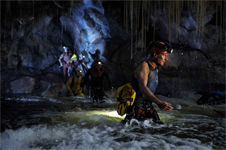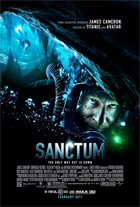Sanctum
|  Perhaps because most American filmgoers won’t have any familiarity with anyone associated with Sanctum either in front of or behind its 3-D cameras, the advertising campaign has relied heavily on the name value of executive director James Cameron, so much so that you might think from the trailers and posters that it was Cameron’s directorial follow-up to Avatar (2009) even though its closest cousin in the Cameron canon is The Abyss (1989), his much underappreciated underwater sci-fi epic. The two films have quite a bit in common--a fetishistic marriage of technology and adventurism, hard-scrabble, working-class heroes, significant amounts of time spent deep underwater--but Sanctum comes up far short in both the character department and any binding thematics. For a film about what lies beneath, it is nothing but surface. Perhaps because most American filmgoers won’t have any familiarity with anyone associated with Sanctum either in front of or behind its 3-D cameras, the advertising campaign has relied heavily on the name value of executive director James Cameron, so much so that you might think from the trailers and posters that it was Cameron’s directorial follow-up to Avatar (2009) even though its closest cousin in the Cameron canon is The Abyss (1989), his much underappreciated underwater sci-fi epic. The two films have quite a bit in common--a fetishistic marriage of technology and adventurism, hard-scrabble, working-class heroes, significant amounts of time spent deep underwater--but Sanctum comes up far short in both the character department and any binding thematics. For a film about what lies beneath, it is nothing but surface.The screenplay was written by John Garvin and Andrew Wight, the latter of whom is an underwater explorer and documentarian who produced two of Cameron’s underwater IMAX documentaries (2003’s Ghosts of the Abyss and 2005’s Aliens of the Deep). Wight based the film on his own personal experiences, and while his direct knowledge of cave and deep underwater exploration gives the film a sharp edge of verisimilitude and plenty of realistic-sounding shoptalk, he and Garvin are unable to translate any of it to meaningful character dynamics, instead relying on a handful of rather stale interpersonal and professional conflicts to drive the story. The majority of the action takes place deep beneath the earth’s surface in the Esa-ala Caves of Papua New Guinea, which are being mapped by a team of professional underground explorers led by Frank (Richard Roxburgh), a tough, no-nonsense veteran who is more comfortable in a cave thousands of feet under the ground than with ordinary human beings. The exploration is being funded by Carl (Ioan Gruffudd), a young, reckless financier who likes to take part in the exploration and brings along his new girlfriend Victoria (Alice Parkinson), who he met while climbing Everest. The other major character is Josh (Rhys Wakefield), Frank’s stylishly coiffed teenage son who is already a veteran cave explorer simply because his father has been dragging him along on these expeditions since he was a child. Josh is unabashedly bitter and resentful of his emotionally distant father who treats him like another employee, rather than a son. Things take a turn for the worst when Papua New Guinea is hit by a major tropical storm that threatens to flood the cave system, and the only known exit is blocked by a fallen boulder. Thus, Frank, Josh, Victoria, and several other team members must forge ahead deeper into the caves in order to find a way out. Their path to the light is blocked by all manner of obstructions both physical (falling rocks, collapsing tunnels, violent whirlpools, seemingly endless chasms) and physiological (one character begins to suffer from the bends after coming up from a dive too quickly and another begins to lose his mind under the stress of the situation). Much of the distance they must traverse is actually underwater, as the cave system acts as a kind of massive drain for rainwater to find its way to the ocean, which introduces a whole new laundry list of dangers, particularly the all-too-symbolic threat of drowning. Director Alister Grierson, whose feature debut was the Australian war film Kokoda (2009), manages to keep the tension high once the plot kicks into full gear, although he struggles with the film’s opening passages, which drag awkwardly as he introduces the various characters and their conflicts. Grierson resists romanticizing any of the characters, but in the process makes them a bit too flat and gruff; while the father-son dynamic between Frank and Josh develops some level of involvement by the end, it isn’t quite enough to give the film any sense of real emotional depth. There is plenty of physical depth, however, and the depiction of the underwater caves and the dangers they pose has an inherent fascination for anyone who has ever wondered about the parts of the planet that human eyes have never seen. Some of Sanctum’s best moments involve the characters facing seemingly insurmountable challenges, although it starts to take on the rhythm of a slasher film by the midway point, with the cave system itself playing the role of the murderous bogeyman, offing characters one-by-one in increasingly nasty ways (one bit in which a character’s hair gets caught in the gear is particularly gruesome). Yet, at times the film takes death seriously, particularly when one character has to purposefully drown another to end his suffering. It’s a moving and painful moment, but not quite enough to give Sanctum a lasting emotional kick. Despite its three-dimensional imagery, the film remains resolutely two-dimensional. Copyright ©2010 James Kendrick Thoughts? E-mail James Kendrick All images copyright © Universal Pictures |
Overall Rating: 
 (2)
(2)


